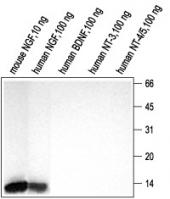Ngf Rabbit Polyclonal Antibody
Other products for "Ngf"
Specifications
| Product Data | |
| Applications | IHC, WB |
| Recommended Dilution | WB: 1:200-1:2000; IHC: 1:100-1:3000 |
| Reactivities | Human, Mouse, Rat |
| Host | Rabbit |
| Clonality | Polyclonal |
| Immunogen | Highly purified 2.5 S mouse NGF. |
| Formulation | Lyophilized. Concentration before lyophilization ~0.8mg/ml (lot dependent, please refer to CoA along with shipment for actual concentration). Buffer before lyophilization: Phosphate buffered saline (PBS), pH 7.4, 1% BSA, 5% sucrose (no preservative). |
| Purification | Affinity purified on immobilized antigen. |
| Conjugation | Unconjugated |
| Storage | Store at -20°C as received. |
| Stability | Stable for 12 months from date of receipt. |
| Gene Name | nerve growth factor |
| Database Link | |
| Background | The neurotrophins ("neuro" means nerve and "trophe" means nutrient) are a family of soluble, basic growth factors which regulate neuronal development, maintenance, survival and death in the CNS and the PNS. NGF, the first member of the family to be discovered, was originally purified as a factor able to support survival of sympathetic and sensory spinal neurons in culture. It is synthesized and secreted by sympathetic and sensory target organs and provides trophic support to neurons as they reach their final target.Neurotrophin secretion also increases in the nervous system following injury. Schwann cells, fibroblasts, and activated mast cells normally synthesize NGF constitutively, however direct trauma and induced cytokines combine to increase neurotrophin production in these cells after injury.NGF is purified in three forms: the 7S, 2.5S and Ã?. The 7S, 130 kDa, form occurs naturally in mouse submaxillary glands, and is a multimeric protein composed of two a, one Ã? and two ? subunits. The name is derived from its sedimentation co-efficient, 7S. The biologically active subunit is the Ã?, which is a 26 kDa dimer composed of two identical 120 amino acid chains held together by hydrophobic interactions.5 The 2.5S form is 9 amino acids shorter than the Ã? form, because of proteolysis that occurs during the purification process. The structural hallmark of all the neurotrophins is the characteristic arrangement of the disulfide bridges known as the cysteine knot, which has been found in other growth factors such as PDGF. There is a 95.8% homology between the rat and mouse forms, and a 85% homology between the human and mouse.NGF has been shown to regulate neuronal survival, development function and plasticity. Recently, involvement of NGF in processes not involving neuronal cells has been shown, such as asthma, psoriasis10 and wound healing. The biological effects of NGF are mediated by two receptors: TrkA, which is specific for NGF, and p75, which binds all the neurotrophins. |
| Synonyms | Beta-NGF; HSAN5; MGC161426; MGC161428; NGFB; NID67 |
| Reference Data | |
Documents
| Product Manuals |
| FAQs |
{0} Product Review(s)
0 Product Review(s)
Submit review
Be the first one to submit a review
Product Citations
*Delivery time may vary from web posted schedule. Occasional delays may occur due to unforeseen
complexities in the preparation of your product. International customers may expect an additional 1-2 weeks
in shipping.






























































































































































































































































 Germany
Germany
 Japan
Japan
 United Kingdom
United Kingdom
 China
China




